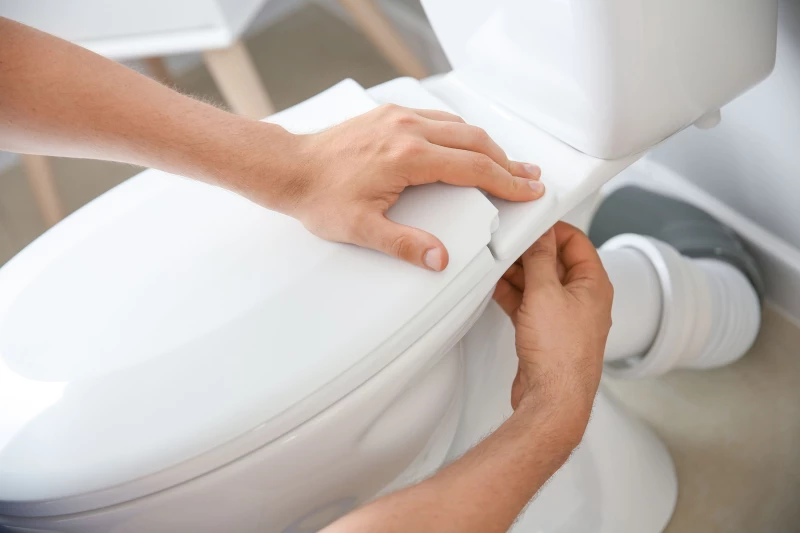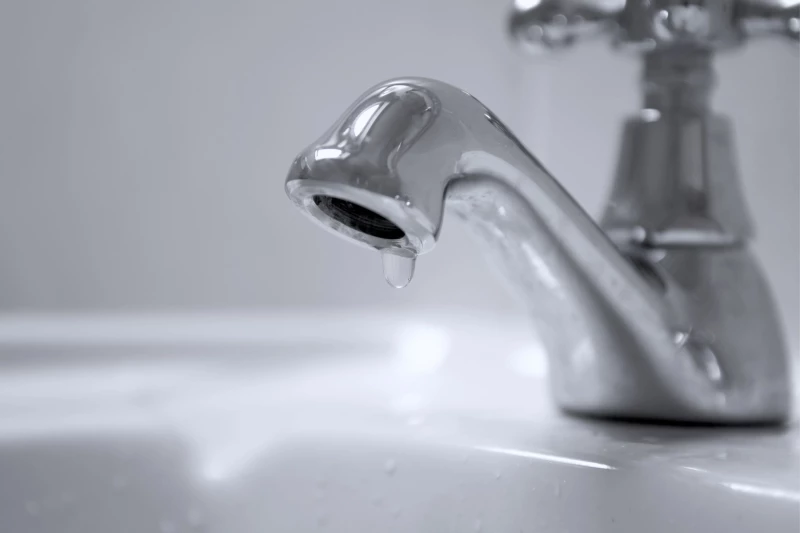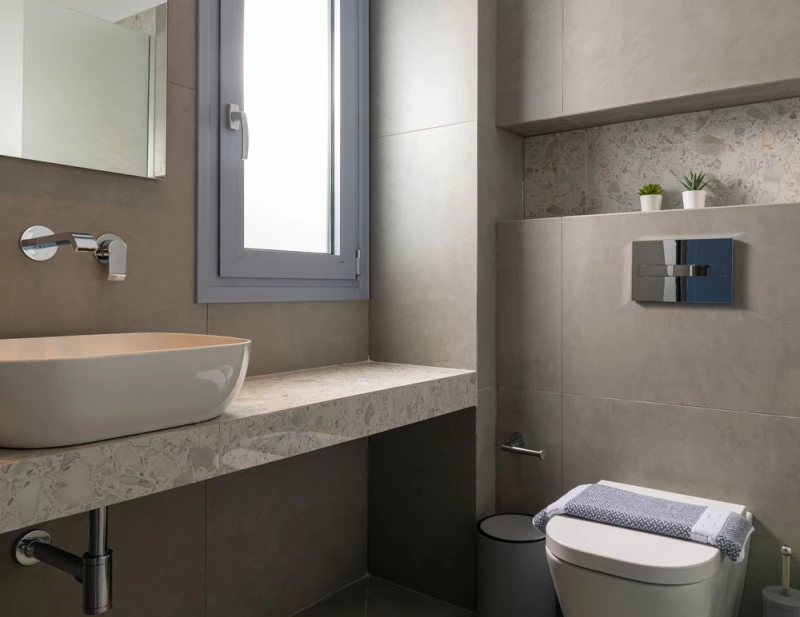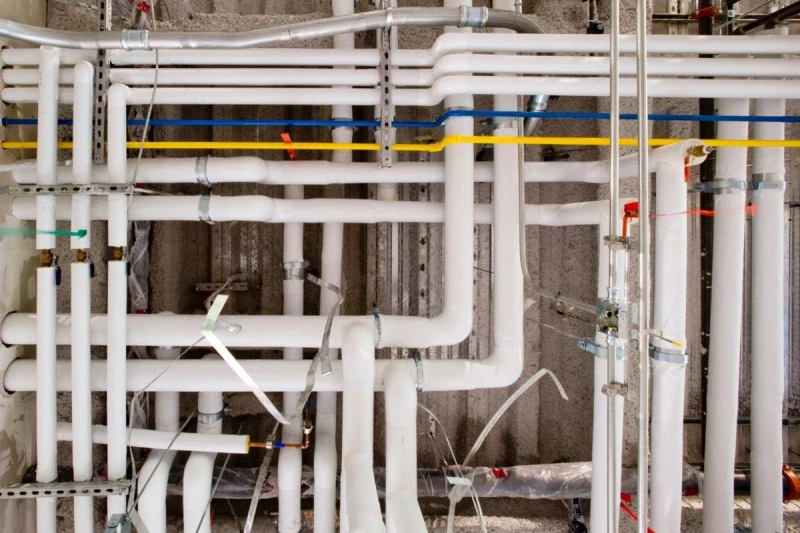Is your toilet leaking, causing frustration and potential water damage? Don’t worry it’s a common issue that can easily be fixed!
Water leakage from toilets affects countless households, causing inconvenience, a high water bill and wasted resources. Whether it’s a slow, constant trickle or an occasional gush, the leakage disrupts the normal functioning of the toilet, compromises its efficiency, and adds unnecessary stress to your daily routine.
In this guide, we’ll uncover the common causes behind this plumbing problem, explain why it occurs, and provide step-by-step instructions for trying to fix it yourself.
The Culprits: Common Causes of a Leaking Toilet
In order to fix a leaking toilet or cistern, you need to identify the underlying cause. Here are some potential causes to consider ruling out when trying to fix a leaking toilet.
Faulty Pan Collar
One of the primary causes of water leaking into the toilet bowl is a worn-out or improperly installed pan collar. The pan collar creates a watertight seal with the toilet base. Over time, the seal can deteriorate or become dislodged, leading to leaks at the base of the toilet.
Damaged Inlet and Outlet Valve
A damaged inlet valve in a toilet can lead to continuous water flow into the cistern, causing overflow and resulting in water leakage onto the floor or into the bowl. Similarly, a faulty outlet valve can cause incomplete sealing of the cistern, leading to slow leakage of water from the cistern into the bowl. Over time, this can cause the water level in the bowl to rise and eventually overflow, causing water to leak onto the floor.
Cracked Toilet Bowl or Cistern
A cracked cistern is another potential source of leakage. Cracks can develop due to age, impact, or stress, allowing water to escape and find its way into the toilet bowl. Carefully inspect the toilet for any visible cracks or fractures.
Blocked Drains
Blocked drains can contribute to a leaking toilet. When drains are blocked or clogged, water may struggle to flow freely through the pipes, resulting in increased pressure and potential backups. In the case of a toilet, if the drain is partially or completely obstructed, flushing can cause water to back up instead of draining properly. The excess pressure from the blocked drain can force water to find alternative escape routes, such as leaks around the toilet seals or even cracks in the toilet bowl itself. This can lead to water leakage around the base of the toilet or onto the floor, causing a potential mess and water damage
Toilet Wear and Tear
Over time, the various components of a toilet can deteriorate due to regular use and age. As we mentioned above, the pan collar, outlet and inlet valve, and other parts may wear out or become damaged, compromising their ability to create a watertight seal and leading to leaks.
Here’s how you can visually assess your toilet for potential issues:
Base
Look for any water stains, discolouration, or signs of moisture around the base of the toilet. These can indicate a pan collar or sealant failure, resulting in leaks.
Cistern
Inspect the cistern for cracks, chips, or any visible damage. Cracks in the cistern can lead to leaks or even complete cistern failure.
Bowl
Check the toilet bowl for cracks, scratches, or other damages. Cracks in the bowl can also cause leaks or compromise the structural integrity of the toilet.
Connections
Examine the connections between the cistern and the bowl, as well as the water supply line. Ensure that there are no visible leaks or loose fittings.
Improper Installation or Maintenance
Incorrect installation or insufficient maintenance practices can contribute to toilet leakage. If the pan collar is not installed properly during toilet installation or routine maintenance tasks like replacing the valve are neglected, leaks can occur.
High Water Pressure
Excessively high water pressure can put a strain on the internal mechanisms of a toilet, causing leaks over time. It’s advisable to check your home’s water pressure and install a pressure regulator if necessary to prevent future issues.
DIY Fixes For Leaking Toilets
If you’re confident in your DIY skills and want to attempt fixing the issue yourself, follow these steps:
1. Inspect and Replace the Pan Collar
Start by turning off the water supply to the toilet. Here’s how:
Locate the water shut-off valve or tap. Look for the water shut-off valve near the base of the toilet or along the wall behind the toilet. It is usually a small oval- or round-shaped valve connected to a water supply line.Turn the valve clockwise. Once you have located the shut-off valve, turn it clockwise (to the right) until it is fully closed. This will stop the water flow to the toilet.
Test the water supply. Flush the toilet to ensure that the water supply has been successfully shut off. The shut-off valve has been properly closed if no water refills the cistern and the bowl.
Remove the toilet by unscrewing the bolts at the base and carefully lifting it off. Inspect the pan collar for any signs of damage or wear.
2. Check and Replace the Outlet and Inlet Valve
Inspect the valve in the toilet cistern. If it appears worn or damaged, remove it and install a new valve. Ensure it creates a tight seal when closed and allows proper water flow during flushing.
3. Assess and Repair
Thoroughly examine the toilet bowl and cistern for any visible cracks or fractures, which could cause a leaking toilet base. If you find any, consider replacing the affected component or consult a professional plumber for guidance.
When to Call In the Professionals
While tackling a leaking toilet on your own can be rewarding, there are instances when it’s best to seek the expertise of professionals. Contact Swan’s Professional Plumbing for assistance in the following situations:
- Significant damage or cracks in the toilet bowl or cistern
- Persistent or recurring leaks, despite your DIY efforts
- Limited plumbing experience or uncertainty in identifying and resolving the issue
Don’t Let Toilet Leaks Dampen Your Spirits — Take Action Today!
Dealing with a toilet leak can be a frustrating and potentially costly problem. By understanding the common causes and taking appropriate DIY steps, you can resolve the issue and restore the functionality of your toilet.
Remember, if all else fails or you prefer professional assistance, contact Swan’s Professional Plumbing for prompt and reliable service. Don’t let a leaking toilet dampen your spirits — take action and regain control over your plumbing today!
With years of experience and industry knowledge, our expert plumbers at Swan’s Professional Plumbing will diagnose the problem accurately and provide efficient solutions to eliminate the toilet leakage problem once and for all.




